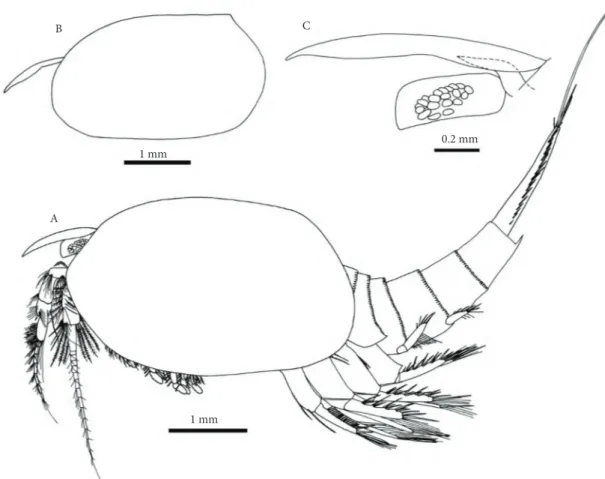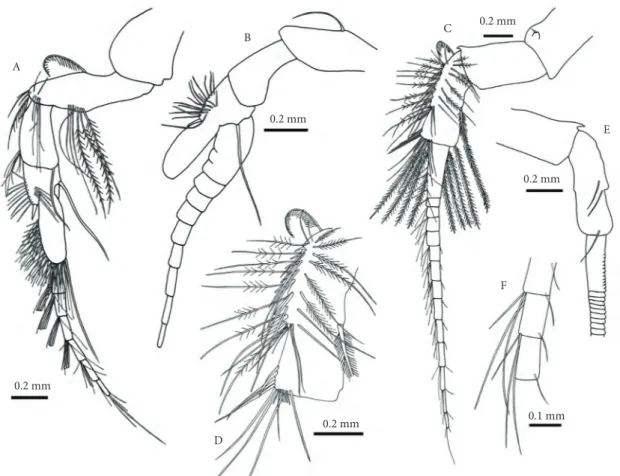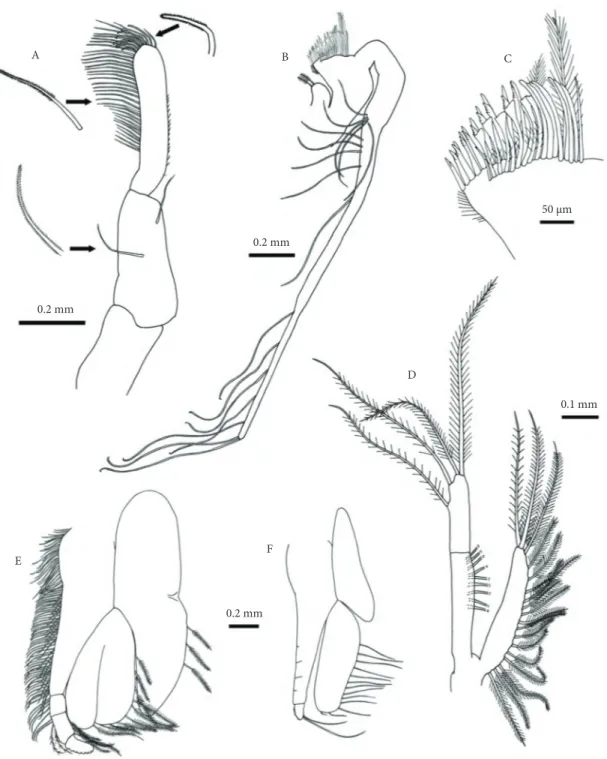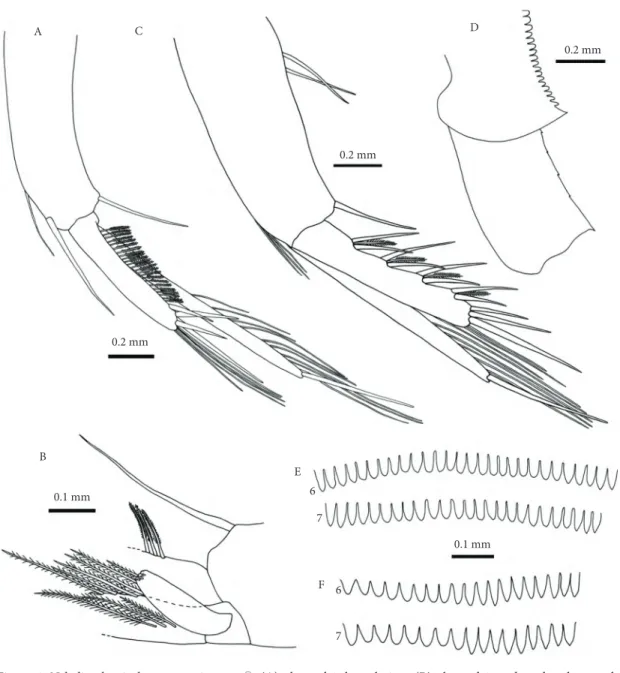2012; 36(3): 351-360 © TÜBİTAK
doi:10.3906/zoo-1012-53
First record of a bathyal leptostracan, Nebalia abyssicola Fage,
1929 (Crustacea: Malacostraca: Phyllocarida), in the Aegean
Sea, eastern Mediterranean
Juan MOREIRA1,2, Murat SEZGİN3,*, Tuncer KATAĞAN4, Onur GÖNÜLAL5, Bülent TOPALOĞLU5 1
Department of Biology (Zoology), Autonomous University of Madrid, Cantoblanco, E-28049 Madrid - SPAIN
2
Marine Biological Station of A Graña, University of Santiago de Compostela, E-15590 Ferrol - SPAIN
3
Sinop University, Fisheries Faculty, Department of Hydrobiology, 57000 Sinop - TURKEY
4
Ege University, Fisheries Faculty, Department of Hydrobiology, 35100 Bornova, İzmir - TURKEY
5
İstanbul University, Fisheries Faculty, Department of Hydrobiology, 34130 Laleli, İstanbul - TURKEY
Received: 13.12.2010
Abstract: Data on deep sea leptostracans (Crustacea: Phyllocarida: Leptostraca) are still scarce in many parts of the
world. In the last few years, several species of Nebalia Leach, 1814, have been reported from the eastern Mediterranean; however, there have been no reports from waters deeper than 100 m. Samples collected recently from Gökçeada, Turkey—at depths of 680-820 m in the Aegean Sea, eastern Mediterranean—included Nebalia abyssicola Fage, 1929. Th is is the fi rst record for the study area and one of the few known records of this species. Specimens are described and fi gured to complement previous descriptions. A key for all known leptostracans from the eastern Mediterranean is also provided.
Key words: Leptostraca, Nebalia abyssicola, Mediterranean Sea, new records, deep waters
Batiyal leptostrakan, Nebalia abyssicola (Crustacea, Phyllocarida)’nın Ege Denizi,
doğu Akdeniz’den ilk kaydı
Özet: Dünyanın bir çok bölgesinde leptostrakanlar üzerine veriler hala yetersizdir. Son yıllarda doğu Akdeniz’de birkaç
Nebalia Leach, 1814 türü rapor edilmiştir ancak 100 m den daha derin sulardan herhangi bir kayıt bulunmamaktadır. Doğu Akdenizde, Gökçeada’da 680 ve 820 m derinliklerden elde edilen çalışma örnekleri Nebalia abyssicola Fage, 1929’nın varlığını göstermiştir. Bu tür çalışma bölgesi için yeni kayıttır ve ender kayıtlarından biridir. Bireyler önceki tanımlamalara dayalı olarak tanımlanmış ve şekillleri çizilmiştir. Aynı zamanda doğu Akdeniz’de bilinen bütün leptostrakanlar için bir tayin anahtarı oluşturulmuştur.
Anahtar sözcükler: Leptostraca, Nebalia abyssicola, Akdeniz, yeni kayıtlar, derin sular
Research Article
Introduction
Although they were fi rst discovered over 200 years ago, leptostracans (Crustacea: Phyllocarida: Leptostraca) are still poorly known in many parts of the world. In general, most of the known species are found in shallow ocean waters (<100 m) on sandy-muddy bottoms typically associated with seagrasses and algae (Rainer and Unsworth, 1991; Haney and Martin, 2004; Moreira et al., 2004). Records of deep sea leptostracans are scarce when compared to those from neritic areas (but see Fage, 1929; Hessler and Sanders, 1965; Mauchline and Gage, 1983; Hessler, 1984; Ledoyer, 1997; Haney et al., 2001). Nevertheless, it has been shown that leptostracans can be collected in large numbers from deep seas using baited traps because of the necrophagous habits of some species (Biernbaum and Wenner, 1993).
In the Mediterranean Sea most of the previous records of leptostracans were attributed to
Nebalia bipes Fabricius, 1780 (e.g., Citarella, 1965;
Macquart-Moulin, 1979). Dahl (1985) restricted the distribution of N. bipes to Arctic latitudes and listed
N. strausi Risso, 1826 and N. clausi Dahl, 1985 in
the western Mediterranean. Later, Ledoyer (1997) recorded the presence of N. strausi; N. herbstii Leach, 1814; and Sarsinebalia typhlops (Sars, 1870) in the western Mediterranean. In the same work, the author also described N. biartiaculata Ledoyer, 1997 and recognised the deep sea species (410-2368 m) N.
abyssicola Fage, 1929 as a valid species.
Recently, 2 species of leptostracans have been reported from the eastern Mediterranean from samples collected at several localities in the Aegean Sea and Cyprus: N. strausi and N. kocatasi Moreira, Koçak and Katağan, 2007 (see Koçak and Katağan, 2006; Koçak et al., 2007, 2010; Moreira et al., 2007). Koçak et al. (2010) also reported several specimens from the Aegean Sea that might represent 2 new species of Nebalia. On the other hand, some specimens reported as N. bipes (Fabricius, 1780) from Cyprus by Kocataş et al. (2001) were later identifi ed as N. strausi (Koçak et al., 2007). In general, all these reports of leptostracans come from specimens collected in shallow waters (<100 m). Th e present work is the fi rst record of the bathyal species N. abyssicola for the eastern Mediterranean. It is based on 2 specimens collected at 820 m off Gökçeada that are described
and fi gured to complement the description of the species.
Materials and methods
Specimens of N. abyssicola were collected in the Mediterranean Sea at 820 m in the Aegean Sea off the coast of Gökçeada, Çanakkale Province, Turkey, using baited traps set on the seabed. All material was identifi ed using the description of the species given by Ledoyer (1997); the original description by Fage (1929) was brief and did not provide much detail about many characters. Samples were washed through a 0.5 mm mesh sieve. Th en specimens were sorted using a binocular microscope, identifi ed, counted, and preserved in 70% ethanol.
Line drawings of specimens were made with the aid of a camera lucida connected to a compound microscope; measurements were made using an ocular micrometer. Total length (TL) was measured from the articulation between the rostrum and the carapace to the posterior end of the caudal furca (excluding setation); rostrum length (RL) was measured along the midline; dorsal carapace length (DCL) was measured as the distance between the articulation of the rostrum and the margin of the posterodorsal cleft ; lateral carapace length (LCL) was measured as the distance along the lateral surface between the anteriormost and posteriormost margins; carapace height (CH) was measured between the dorsalmost and the ventralmost margins. Specimens were deposited in the Marine Biology and Ecology Laboratory, Sinop University, Turkey.
Results and discussion
Family Nebaliidae Samouelle, 1819 Genus Nebalia Leach, 1814
Nebalia abyssicola Fage, 1929
(Figures 1-5)
Fage, 1929: 41-42, fi gures 88-89. Ledoyer, 1997: 29-31, fi gure 1.
Material examined. Post-ovigerous ♀, TL 6.6 mm, RL 1.1 mm, DCL 2.5 mm, LCL 3.6 mm, CH 2.5 mm; off Gökçeada, 40°19ʹ16ʺN, 25°52ʹ79ʺE; April 2010; mud, clay, depth 680 m; ♂, TL 6.6 mm, RL 1.0
mm, DCL 2.5 mm, LCL 3.2 mm, CH 2.2 mm; off Gökçeada, Turkey, 40°21ʹ35ʺN, 25°53ʹ10ʺE; April 2010; mud, clay, depth 820 m.
Diagnosis. Compound eye sub-rectangular, lacking visual pigment. Ommatidia irregularly distributed between posterior part of proximal third and distal part of posterior third of eye. Antennular scale oval, 2.7 times as long as wide. On fourth antennular article, 1 short distal spine. Th ird antennal peduncle lateral margin with several proximal plumose setae and 3 distal thin, long spines. Second maxilla endopod proximal article longer than distal article. Second maxilla exopod slightly longer than fi rst article of endopod. Denticles along posterior dorsal borders of pleonites 6-7 distally rounded. Pleopod 4 protopod posterior border with 4 acute serrations; posterolateral corner acutely pointed. Uropods longer than pleonite 7 and anal somite combined. Terminal seta of uropods longer than
entire ramus.
Description of post-ovigerous female. Fixed specimen whitish. Carapace more or less oval, covering partially lateral sides of pleonites 3-4 (Figure 1A). Rostrum long, extending beyond eyestalk, with parallel margins. Compound eye more or less rectangular, inferior distal border slightly turned downwards; ommatidia irregularly distributed between posterior part of proximal third and distal part of posterior third of eye (Figure 1C). Eyestalk not lobed. Supraorbital scale tapering distally to acute tip, slightly less than half the length of eyestalk.
Antennular peduncle 4-segmented (Figure 2A). First article shorter than eyestalk. Second article with plumose seta arising from anterior third, with cluster of 7-8 setae (some of them plumose) arising from posterolateral surface, and subterminal cluster of short and long simple setae. Th ird article shorter
B C
A
1 mm
1 mm
0.2 mm
Figure 1. Nebalia abyssicola - (A) whole animal, lateral view (post-ovigerous ♀); (B) carapace and rostrum, lateral view (♂); (C) rostrum, supraorbital scale, and eye, lateral view (post-ovigerous ♀).
than second, widest distally, with cluster of simple setae on superior distal margin, 1 simple long seta on inferior distal margin. Fourth article shorter than third with (1) medial row of 9 simple setae, (2) 1 thick short spine distally, (3) lateral row of 5 simple setae, (4) simple long seta arising from inferior distal margin, longer than antennular scale. Antennular scale oval, about 2.7 times as long as wide; anterior margin convex with (1) row of setae provided with teeth along margin of distal half, (2) numerous simple setae of diff erent lengths, (3) 1 long simple seta arising from inferior distal margin. Flagellum well developed, with 11 articles, shorter than peduncle; each article with several aesthetascs and simple setae on anterodistal margin.
Antennal peduncle 3-segmented (Figure 2C). First article with anterodistal process ending in small acute spine. Second article with distal acutely pointed process. Th ird article longer than second; 1 plumose seta on proximal margin and several rows of setae along medial anterior margin (Figure 2D): (1) 5 sparsely plumose setae of growing length and 3 thin spine-like setae, the distalmost slightly longest and associated with several longer and thinner setae, (2) 10 simple setae, the distalmost associated with 2 simple thinner setae, (3) 8 setae shorter and in general thicker than those of (2) along proximal half, being the longest distalmost, (4) 8 long, sparsely plumose setae along medial internal border, (5) terminal row of 8 spines, increasing distally in length, the 2
C B A 0.2 mm 0.2 mm 0.2 mm 0.2 mm 0.2 mm 0.1 mm D E F
Figure 2. Nebalia abyssicola - (A) antennule, lateral view (post-ovigerous ♀); (B) antennule, lateral view (♂); (C) an-tenna, lateral view (post-ovigerous ♀); (D) anan-tenna, third article, external side, lateral view (post-ovigerous ♀); (E) antenna, peduncle, and proximal half of fl agellum, lateral view (♂); (F) antenna, detail of fl agellum (post-ovigerous ♀). (B) and (E): only selected setae illustrated.
distalmost thinner than the others; long plumose seta on posterior margin; cluster of 8 plumose setae along distal interior margin. Flagellum composed of 13-14 articles; each article with 4 terminal setae, 1 shorter than the others (Figure 2F).
Mandibular palp 3-segmented (Figure 3A). Second article with 2 setae: 1 simple seta on lateral margin at mid-length and 1 distally plumose seta on distal third. Th ird article longer than second; proximal half of superior margin with row of short setae; inferior margin with 3 rows of setae (1) plumose setae from ending of proximal third extending to fi rst half, (2) longer plumose setae than those of (1) extending along distal half, (3) about 9 curved, dentate setae along distal margin.
First maxilla proximal endite with rounded medial margin bearing simple plumose setae (Figure 3B). Distal endite larger than proximal; medial margin with 2 plumose setae and 3 rows of setae, (1) 10 setae of increasing size with 3 large teeth along distal inferior margin accompanied by several smaller teeth, (2) 6 spatulate setae, (3) row of 8 setae with several teeth along distal superior margin (Figure 3C). Palp well developed, 4.5 times length of protopod; long and spaced setae along entire length, setae with small setules along their length and apex recurved distally.
Second maxilla endopod 2-segmented, longer than exopod, proximal article about 1.4 times as long as distal one (Figure 3D); medial margin with spaced plumose setae; second article with 4 distal and subdistal setae, the distalmost longer than endopod. Exopod slightly longer than proximal article of endopod; medial margin with several plumose setae and 2 distalmost setae, the latter about as long as exopod.
Th oracopod endopod longer than exopod; numerous setae along anterior margin. Distal article of endopod slightly enlarged, more or less directed backwards, setae lost (Figure 3E). Endopod segmentation more or less defi ned at distal third. Exopod with about 10-13 plumose setae along posterior margin. Epipod with 3 plumose setae along posterior border of distal half. Th oracopod 8 epipod smaller than those of thoracopods 1-7, lacking setae (Figure 3F).
Pleopods 1-4 stenopodous, with protopod, endopod, and exopod (Figures 4A-C). First pleopod protopod with 3 basal simple setae: (1) shorter seta arising subdistally, (2) thicker seta between the 2 rami, (3) long seta near base of exopod, reaching fi rst half of exopod spine-row. Endopod 2-segmented, longer than exopod; distal article with about 10 plumose setae along lateral and medial margins, distal margin with long terminal seta. Basal article shorter, appendix
interna provided with 3 short recurved hooks. Exopod
about 0.7 times as long as protopod; row of about 23 short serrate spines along lateral border (“spine-row”), each spine with tridentate tip, central tooth bifi d; 4 stout spines on distolateral border, distalmost the longest; long plumose setae along medial margin. Pleopods 2-4 similar. Protopod with 2 setae on posterior distal borders, cluster of 3 setae subdistally; pleopods 2-3 protopod with posterior margin even. Endopod longer than exopod, 2-segmented; proximal article short and provided with appendix interna; distal article with about 10 plumose setae along lateral and medial borders, ending in long spine. Exopod with row of 4 spine pairs, each pair consisting of 1 superior long and 1 inferior shorter spine, with short plumose seta in between; medial margin with long plumose setae and 3 distal spines of increasing size. Pleopod 4 protopod with 4 acute serrations along posterior border (Figure 4D); posterior corner acutely produced.
Pleonite 4 with distally rounded denticles along posterior lateral border, posterior lateral corner acutely pointed. Dorsal posterior margin of pleonites 6-7 with denticles distally rounded (Figure 4E). Distal-lateral posterior margins with denticles slightly pointed (Figure 4F); lateral posterior margins with denticles distally rounded.
Pleopod 5 uniramous, 2-segmented (Figure 5A). Distal article about 4.5 times as long as wide with conical spines along distolateral and terminal border, the proximalmost the shortest. Several simple setae along medial and distal borders, setae appearing jointed at middle length. Pleopod 6 uniramous, 1-segmented (Figure 5B); 5 conical spines along distolateral and terminal border, the distalmost the longest. Medial and terminal borders with “jointed” setae similar to those of fi ft h pleopod. Pleopod 5-6 pairs with acute triangular process between bases of rami.
C B A 0.2 mm 0.2 mm 50 μm 0.2 mm 0.1 mm D E F
Figure 3. Nebalia abyssicola - post-ovigerous ♀: (A) mandibular palp and detail of setae; (B) fi rst maxilla; (C) fi rst maxilla, detail of distal endite and setae; (D) second maxilla; (E) thoracopod 3; (F) thoracopod 8. (E) and (F): same scale.
Anal somite (pleonite 8) slightly longer than pleonite 7. Anal plates acutely tapering distally, lacking distinct “shoulder” (Figure 5C). Uropods elongate, more than twice the length of pleonite 8 (Figure 5D). Each uropod with 20-23 setae along
lateral margin, increasing in size distally, the terminal longer than entire ramus; several simple and plumose setae on lateral inner margins.
Male. Th e only male examined is very similar to the female. Th e male is distinguished from the female C B A 0.2 mm 0.2 mm 6 7 6 7 0.2 mm 0.1 mm 0.1 mm D E F
Figure 4. Nebalia abyssicola - post-ovigerous ♀: (A) pleopod 1, lateral view; (B) pleopod 1, endopod and exopod, proximal part; (C) pleopod 2, lateral view; (D) pleonite 4 lateral border and pleopod 4 protopod, lateral view; (E) pleonites 6-7, posterior dorsal border, denticles; (F) pleonites 6-7, posterior lateral border, den-ticles. (A) and (C): setules not illustrated for long plumose setae; (E) and (F): same scale.
by its greater number of articles in the antennal fl agellum (Figure 2E), its more swollen articles of the antennular fl agellum (Figure 2B), and its carapace, which is slightly longer than wide in comparison to that of the female (Figure 1B).
Remarks. Ledoyer (1997) elevated Nebalia bipes
abyssicola to species rank, distinguishing this species
from other Nebalia mostly on the basis of the lack of eye pigment and the appearance of ocular elements; the eyes of N. b. abyssicola are more rectangular than the typical dorsally-convex eye of most members of this genus (Dahl, 1985; Martin et al., 1996; Olesen, 1999; Haney and Martin, 2000). Th e eyes of bathyal and deep sea species of Nebalia tend to have aberrant eye shapes that lack pigment (Fage, 1929; Haney et al., C B A 0.2 mm 0.1 mm 0.1 mm D
Figure 5. Nebalia abyssicola - post-ovigerous ♀: (A) pleopod 5, ventral view; (B) pleopod 6, ventral view; (C) anal scales, ventral view; (D) uropods, ventral view (setules not illustrated; medial border of left uropod: only plumose setae illustrated; medial border of right uropod: only simple setae illustrated). (A) and (B): same scale.
2001). Nebalia abyssicola is also characterised by the presence of 1 thick distal spine in the fourth article of the antennular peduncle and by the antennular scale, which is more than twice as long as wide, and whose denticles on the posterior dorsal margin of pleonites 6-7 are distally rounded. Specimens from the eastern Mediterranean also have distinctive setae on the lateral margin of the third article of antennal peduncle. For example, there are 6 sparsely plumose setae along the proximal half followed by 2 thin spine-like setae and additional spine-like seta on the distal position that are slightly thicker than the others. Th ese setae were not explicitly described by Ledoyer (1997) for specimens from the western Mediterranean. However, an accurate description of those setae may be useful to distinguish Nebalia species (Moreira et al., 2009). Th us, their disposition and shape in N. abyssicola is diff erent from those of the other eastern Mediterranean leptostracans (N.
strausi: Koçak et al., 2007, fi gure 2F; N. kocatasi:
Moreira et al., 2007, fi gure 3C; Nebalia sp. 1: Koçak et al., 2010: fi gure 2E; Nebalia sp. 2: Koçak et al., 2010: fi gure 4E); the 3 distalmost setae are much thinner in comparison to their length in N. abyssicola than in the aforementioned 4 species of Nebalia.
Key to the leptostracans of the eastern Mediterranean
1. Eye sub-rectangular; ommatidia irregularly distributed over central part of eye.... N. abyssicola 1’. Eye convex; ommatidia present in distal half of
eye ... 2 2. Proximal and distal segments of second maxilla
endopod subequal in length ... N. kocatasi 2’. Proximal article of second maxilla endopod
clearly longer than distal segment ... 3 3. Pleonites 6-7 posterior dorsal border with distally
acute denticles ... N. strausi 3’. Pleonites 6-7 posterior dorsal border with
denticles of diff erent shape ... 4 4. Second maxilla exopod about same length of
proximal article of endopod; the latter about 1.8 length of distal article ... ... Nebalia sp. 1 (sensu Koçak et al., 2010) 4’. Second maxilla exopod longer than proximal
article of endopod; the latter about 1.3 times as long as distal article ... ... Nebalia sp. 2 (sensu Koçak et al., 2010)
References
Biernbaum, C.K. and Wenner, E.L. 1993. Trapping of necrophagous crustaceans on the upper continental slope off South Carolina, USA. J. Crust. Biol. 13: 601-608.
Citarella, G. 1965. Sur une espèce indicatrice de pollution des eaux marines. Rev. Trav. Inst. Pêches Marit. 29: 179-182.
Dahl, E. 1985. Crustacea Leptostraca, principles of taxonomy and a revision of European shelf species. Sarsia 70: 135-165. Fabricius, O. 1780. Fauna Groenlandica. Hafniae.
Fage, L. 1929. Cumacés et Leptostracés provenant des Campagnes Scientifi ques du Prince Albert Ier de Monaco. Résult. Camp. scient. Prince Albert I 77: 1-50.
Haney, T.A., Hessler, R.R. and Martin, J.W. 2001. Nebalia
schizophthalma, a new species of leptostracan (Malacostraca)
from deep waters off the east coast of the United States. J. Crust. Biol. 21: 192-201.
Haney, T.A. and Martin, J.W. 2000. Nebalia gerkenae, a new species of leptostracan (Crustacea: Malacostraca: Phyllocarida) from the Bennett Slough region of Monterey Bay, California. Proc. Biol. Soc. Wash. 113: 996-1014.
Haney, T.A. and Martin, J.W. 2004. A new genus and species of leptostracan (Crustacea: Malacostraca: Phyllocarida) from Guana Island, British Virgin Islands, and a review of leptostracan genera. J. Nat. Hist. 38: 447-469.
Hessler, R.R. 1984. Dahlella caldariensis, new genus, new species: a leptostracan (Crustacea, Malacostraca) from deep-sea hydrothermal vents. J. Crust. Biol. 4: 655-664.
Hessler, R.R. and Sanders, H.L. 1965. Bathyal Leptostraca from the continental slope of the Northeastern United States. Crustaceana 9: 71-74.
Koçak, C. and Katağan, T. 2006. A new record of Nebalia straus Risso, 1827 (Phyllocarida, Leptostraca) from the eastern Mediterranean. Crustaceana 79: 319-325.
Koçak, C., Moreira, J. and Katağan, T. 2007. First occurrence of
Nebalia straus Risso, 1827 (Phyllocarida, Leptostraca) in the
Levantine Basin (eastern Mediterranean). Crustaceana 80: 447-453.
Koçak, C., Moreira, J. and Katağan, T. 2010. New records of Leptostracans (Crustacea, Phyllocarida) from the eastern Mediterranean. Turk. J. Zool. 34: 69-77.
Kocataş, A., Katağan, T. and Benli, H.A. 2001. Contribution to the knowledge of the Crustacean fauna of Cyprus. Isr. J. Zool. 47: 147-160.
Leach, W.E. 1814. Nebalia. Zool. Misc. 1: 99-100.
Ledoyer, M. 1997. Leptostracés (Crustacea) de Méditerranée. Mar. Life 7: 29-38.
Mauchline, J. and Gage, J.D. 1983. Th e Nebaliacea (Crustacea: Leptostraca) of the Rockall Trough. J. Mar. Biol. Ass. U.K. 63: 627-631.
Macquart-Moulin, C. 1979. Rythme d’activité endogène chez un nébaliacé (Crustace phyllocaride). J. Exp. Mar. Biol. Ecol. 37: 281-296.
Martin, J.W., Vetter, E.W. and Cash-Clark C.E. 1996. Description, external morphology, and natural history observations of
Nebalia hessleri, new species (Phyllocarida: Leptostraca), from
southern California, with a key to the extant families and genera of the Leptostraca. J. Crust. Biol. 16: 347-372.
Moreira, J., Díaz-Agras, G., Candás, M., Señarís, M.P. and Urgorri, V. 2009. Leptostracans (Crustacea: Phyllocarida) from the Ría de Ferrol (Galicia, NW Iberian Peninsula), with description of a new species of Nebalia Leach, 1814. Sci. Mar. 73: 269-285. Moreira, J., Koçak, C. and Katagan, T. 2007. Nebalia kocatasi sp. nov.,
a new species of leptostracan (Crustacea, Phyllocarida) from Izmir Bay (Aegean Sea, eastern Mediterranean). J. Mar. Biol. Assoc. U. K. 87: 1247-1254.
Moreira, J., Quintas, P. and Troncoso, J.S. 2004. Sobre la presencia de Nebalia strausi Risso, 1826 (Crustacea, Leptostraca) en la península Ibérica. Bol. R. Soc. Esp. Hist. Nat. (Biol.) 99: 83-92.
Olesen, J. 1999. A new species of Nebalia (Crustacea, Leptostraca) from Unguja Island (Zanzibar), Tanzania, East Africa, with a phylogenetic analysis of leptostracan genera. J. Nat. Hist. 33: 1789-1809.
Rainer, S.F. and Unsworth, P. 1991. Ecology and production of
Nebalia sp. (Crustacea: Leptostraca) in a shallow-water
seagrass community. Aust. J. Mar. Freshwat. Res. 42: 53-68.
Risso, A. 1826. Histoire naturelle des principales productions de l’Europe Méridionale et particulièrement de celles des environs de Nice et des Alpes maritimes. Vol. 5 Animaux Articulés, Annelides, Crustacés, Arachnides, Myriapodes et Insectes. F.-G. Levrault, Paris.
Samouelle, G. 1819. Th e entomologists’ useful compendium; or an introduction to the knowledge of British Insects, comprising the best means of obtaining and preserving them, and a description of the apparatus generally used; together with the genera of Linné, and modern methods of arranging the Classes Crustacea, Myriapoda, spiders, mites and insects, from their affi nities and structure, according to the views of Dr. Leach. Also an explanation of the terms used in entomology; a calendar of the times of appearance and usual situations of near 3,000 species of British Insects; with instructions for collecting and fi tting up objects for the microscope. Th omas Boys, London.
Sars, G.O. 1870. Nye Dybvandscrustaceer fra Lofoten. Forh. Vidensk Selsk. Christiana 1869: 147-174.




